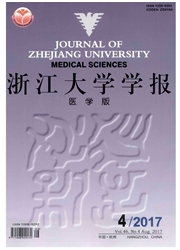

 中文摘要:
中文摘要:
目的:探讨塞来昔布诱导急性早幼粒细胞白血病细胞株MR2细胞凋亡作用及其可能机制。方法:应用MTT法分析塞来昔布对细胞增殖的影响;琼脂糖凝胶电泳进行DNA片段化分析;流式细胞仪检测细胞凋亡情况;PCR检测融合基因PML/RARα和凋亡相关基因Survivin表达;免疫印迹检测caspase-3、9和PARP蛋白表达。结果:MTT示塞来昔布对MR2细胞具有明显的增殖抑制作用,并具有时间和剂量依赖性。琼脂糖凝胶电泳见DNA片段化,形成典型梯状条带。流式细胞仪检测发现塞来昔布处理24h后,随着作用浓度增加,MR2细胞早期凋亡率从5.06%增至36.1%,细胞内Survivin表达降低而PML/RARα无明显变化。同时伴有caspase-3、9和PARP蛋白的激活。结论:塞来昔布能够通过诱导凋亡抑制MR2细胞增殖,其机制可能与抑制Survivin表达有关,但与融合基因PML/RARα无明显关系。
 英文摘要:
英文摘要:
Objective- To investigate celecoxib-induced apoptosis of acute promyelocytic leukemia cell line MR2 and related mechanism. Methods. MR2 cells were treated with celecoxib at different concentrations (0,20,40,80,120 and 160 μmol/L). The proliferation of MR2 cells was observed by MTT assay and apoptosis was detected by DNA fragmentation analysis and flow cytometry with Annexin V-FITC/PI staining. The expression of survivin and PML/RARamRNA was examined by RT-PCR and nested-PCR,and the protein expression of caspase-3,9 and PARP was analyzed by Western-blot. Results: After treatment with celecoxib the viability of MR2 cells decreased markedly in a doseand time-dependent manner, and a DNA ladder pattern of internucleosomal fragmentation was observed. The translocation of phosphatidylserine at the outer surface of the cell plasma membrane was induced by celecoxib and its level increased following the augmentation of the drug concentration. The expression of survivin mRNA decreased dramatically while no significant change with PML/RARa. Treatment with celecoxib for 24h resulted in the activation of caspase-3 and 9,cleavage of PARP. Conclusion: Celecoxib could inhibit MR2 cell proliferation by inducing apoptosis, which might be mediated by the caspase-3 and 9 activation and PARP cleavage. Moreover,the down-regulation of survivin may play a certain role in apoptosis of MR2 cells induced by celecoxib.
 同期刊论文项目
同期刊论文项目
 同项目期刊论文
同项目期刊论文
 期刊信息
期刊信息
